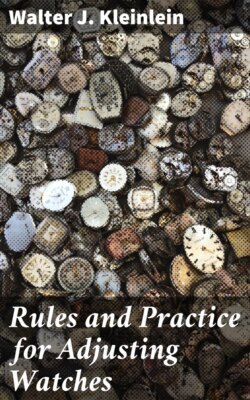Читать книгу Rules and Practice for Adjusting Watches - Walter J. Kleinlein - Страница 23
На сайте Литреса книга снята с продажи.
11.Commercial System.
ОглавлениеIn manufacturing watches for commercial purposes, both foreign and domestic, the tests are generally made for twenty-four hours in each temperature and the difference in the rates is considered as the total error.
Sometimes preliminary tests of four or six hours in each temperature are made to obtain an estimate as to the extent of error, then alterations are made, after which the watch is subjected to the regular twenty-four hour test. There is nothing to be gained by this in regular work, although for a special rush job a day's time may be saved. Watches are always expected to be in first-class condition and such features as close fitting pivots or dirty oil will prevent any dependable timing. It is also advisable to time them closely before the test is made, as too great mean time variation may confuse in estimating the error, especially if the time is not taken in each temperature exactly at the end of twenty-four hours.
The testing should preferably be done in the dial up position to eliminate poise errors as much as possible. The first test is made in heat at 90° Fahr., then in normal temperature of sixty-five or seventy degrees and finally in the lower extreme of 40° Fahr.
When the watch is removed from the cold box it will be covered with moisture which will immediately begin to condense. The time should therefore be quickly noted and the watch replaced in the higher temperature box for four or five hours to become thoroughly dry and prevent against rusting of the steel parts.
